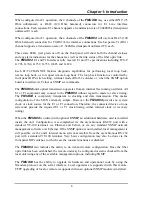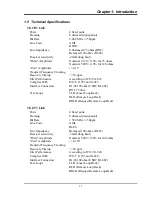
Chapter 1: Introduction
8
When configured for E1 operation, the 4 channels of the
FMUX04
may use either BNC (75
Ohm unbalanced) or RJ-45 (120 Ohm balanced) connectors for E1 Line interface
connections. Each separate E1 channel supports a transmission rate of 2.048Mb/s (transparent
unframed E1) each.
When configured for T1 operation, the 4 channels of the
FMUX04
will use four RJ-45 (100
Ohm balanced) connectors for T1(DS1) Line interface connections. Each separate T1 (DS1)
channel supports a transmission rate of 1.544Mb/s (transparent unframed T1) each.
Three state LEDs (red, green or off) on the front panel will show both the channel statuses
and any alarm indications for the channels as well as the link status of the fiber optic link.
The
FMUX04
E1 and T1 Interfaces fully meet all E1 and T1 specifications including ITU-T
G.703, G.704, G.732, G.733, G.823 and G.824.
Each E1/T1-CHANNEL features diagnostic capabilities for performing local loop back,
remote loop back, or to request remote loop back. The loop back function is controlled by
front panel DIP switch setting, terminal mode (RS-232 console) or, when the SNMP option
board is installed, via Telnet or SNMP set commands.
The
FMUX04
unit's optical transmission operates from an internal free running oscillator. All
E1 or T1 equipment may connect to the
FMUX04
without regard to master or slave timing.
The
FMUX04
is completely transparent to clocking and data transmission. This makes
configuration of the MUX extremely simple. However, the
FMUX04
provides no system
clock or clock source for the E1 or T1 connection. Therefore, the connected device on one
side must provide the required E1 or T1 clock timing (either internal clock or recovery
timing).
When the
FMUX04
is ordered with optional
SNMP
, an additional hardware card is installed
inside the unit. Configuration is accomplished via the asynchronous RS-232 port with a
standard VT-100 terminal, via Ethernet and Telnet, or via any standard SNMP network
management software over Ethernet. If the SNMP option is not installed, local management is
still possible via the unit's internal menu system accessible from the asynchronous RS-232
port with a standard VT-100 terminal. Very basic configuration may also be done via the
front panel DIP switches, in which case the console functions are disabled.
The
FMUX04
also includes the ability to do in-band remote configuration. Once the fiber
optic link has been established, the remote unit may be configured or status checked from the
local unit using any of the available management options, including SNMP.
The
FMUX04
has the ability to upgrade its hardware and operational code by using the
Xmodem protocol on the serial interface. Local upgrades are supported with this feature.
TFTP upgrading of local or remote is supported when an optional SNMP module is installed.
Содержание FMUX04
Страница 2: ......
Страница 16: ...Chapter 1 Introduction 16 This page left blank intentionally ...
Страница 61: ......









































